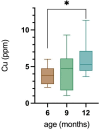Impact of aging on copper isotopic composition in the murine brain
- PMID: 38289854
- PMCID: PMC11494240
- DOI: 10.1093/mtomcs/mfae008
Impact of aging on copper isotopic composition in the murine brain
Abstract
Aging is the main risk factor for Alzheimer's disease (AD). AD is linked to alterations in metal homeostasis and changes in stable metal isotopic composition can occur, possibly allowing the latter to serve as relevant biomarkers for potential AD diagnosis. Copper stable isotopes are used to investigate changes in Cu homeostasis associated with various diseases. Prior work has shown that in AD mouse models, the accumulation of 63Cu in the brain is associated with the disease's progression. However, our understanding of how the normal aging process influences the brain's isotopic composition of copper remains limited. In order to determine the utility and predictive power of Cu isotopes in AD diagnostics, we aim-in this study-to develop a baseline trajectory of Cu isotopic composition in the normally aging mouse brain. We determined the copper concentration and isotopic composition in brains of 30 healthy mice (WT) ranging in age from 6 to 12 mo, and further incorporate prior data obtained for 3-mo-old healthy mice; this range approximately equates to 20-50 yr in human equivalency. A significant 65Cu enrichment has been observed in the 12-mo-old mice compared to the youngest group, concomitant with an increase in Cu concentration with age. Meanwhile, literature data for brains of AD mice display an enrichment in 63Cu isotope compared to WT. It is acutely important that this baseline enrichment in 65Cu is fully constrained and normalized against if any coherent diagnostic observations regarding 63Cu enrichment as a biomarker for AD are to be developed.
Keywords: Alzheimer's disease, biomarker; aging; copper isotopes, MC–ICP–MS, metallomics.
© The Author(s) 2024. Published by Oxford University Press.
Figures







References
-
- McLean C. A., Cherny R. A., Fraser F. W., Fuller S. J., Smith M. J., Beyreuther K., Bush A. I., Masters C. L. Soluble pool of Abeta amyloid as a determinant of severity of neurodegeneration in Alzheimer's disease, Ann. Neurol, 1999, 46 (6),860–866. 10.1002/1531-8249(199912)46:6<860::aid-ana8>3.0.co;2-m - DOI - PubMed
-
- Harman D. Protein oxidation in aging and age-related diseases, Gerontology, 1956, 11, 298–300. 10.1093/geronj/11.3.298 - DOI

